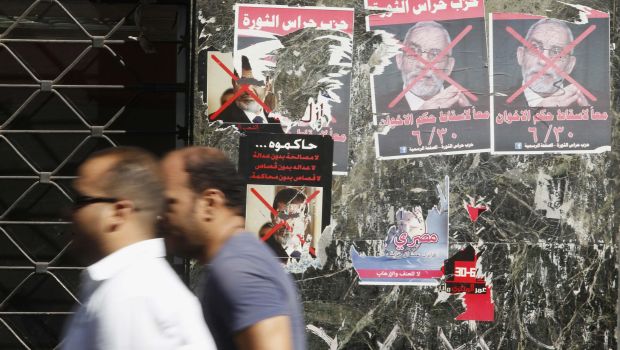Just a few weeks ago, the talk about the Muslim Brotherhood focused on the group’s political collapse and its failure to rule. but there was a massive change, suddenly and without evidence, in terms of the general position towards the Brotherhood, with a number of parties designating it a terrorist organization.
It began in Egypt, where the interim authorities unilaterally designated the Muslim Brotherhood a terrorist organization. In addition to this, General Khalifa Haftar, a former commander of Libya’s armed forces, announced that “the real problem in Libya is the Muslim Brotherhood.” Most recently, in a step that came as a surprise to many, the joint leadership of the Free Syrian Army announced that the Muslim Brotherhood is a “terrorist” organization and banned its activities within Syrian territory.
It seems that the element of surprise has dominated the Brotherhood movement since the launch of the so-called Arab Spring. The Brotherhood benefited the most from the uprisings, whether in Tunisia, Egypt or Libya. In fact, we can even talk about a kind of “Brotherhoodization” of the Arab Spring and Islamization of its politics.
During the first year or so after the Tunisian, Egyptian and Libyan revolutions, Muslim Brotherhood groups experienced a golden age during which their star was on the rise and they were able to dominate the polls.
The Brotherhood’s rise to power was shocking to the political elite, who generally oppose the ideology of political Islam. Its collapse, its inability to reach political consensus with other members of the political arena, not to mention its inexperience and lack of judgment, collectively contributed to destroying the political legitimacy of this group, despite the fact that it came to power via the ballot box. Thus the Brotherhood’s initial rise to power was only equaled by its subsequent collapse.
And just as quickly as it fell from power, its designation as a terrorist organization was just as quick, albeit less surprising even though just a few months ago the group was ruling the largest Arab country: Egypt.
I believe that what the Brotherhood has experienced in terms of the pace of its rise and fall, and later its isolation from political life in terms of its designation as a terrorist organization, deserve a deeper reading that will lead us to an objective, not political, understanding of the process. This has concluded today with the Brotherhood facing a radical rejection, which one could say has become semi-dominant across the Arab regional map. In fact, the whole point of this anti-Brotherhood attitude was escalation, namely that opponents of the Brotherhood, rather than politically isolating the Islamist group, preferred a pre-preemptive showdown. This led to the squeezing of the Brotherhood, nationally and internationally, after its designation as a terrorist organization.
Of course, we may be able to understand the speed of the Brotherhood’s fall, and its subsequent designation as a terrorist organization, when we look at the extent of the qualitative mistakes committed by the organizations and how their agenda was more Islamist than nationalist. And that is not to mention its frequent and shameless embroilment in the phenomena of doublespeak and doublethink.
The political rise of the Muslim Brotherhood groups was due to the fact that the post-revolutionary Arab states were experiencing a political vacuum that could only be filled, at that time, by the Muslim Brotherhood. The Brotherhood capitalized on its public image as a group that, due to its struggle in the name of Islam, had suffered injustice, exile and imprisonment under the dictatorial regimes, particularly in Tunisia, Libya and Egypt prior to the Arab Spring. However, the problem with these groups is that they did not read reality in an objective way, and neither were they able to understand the real reasons behind their rise to power. In fact, even their adoption of the Turkish model of rule was only formal and superficial.
Today, after all the events that shaped the Brotherhood’s experience in the Arab world, perhaps it would be more accurate to say that the Turkish model is parochial, and thus difficult to import. The Turkish model is not the product of a revolution as much as a gradual political movement and the fruit of a long and patient experience in Turkish democracy. The central concept that the state has no official religion characterizes the Turkish model. This concept has fortified the Turkish model against the idea of doublespeak and demonstrated the extent to which Turkey has benefited from Atatürk’s secular vision.
On the other hand, the Brotherhood in the Arab world chose to antagonize moderate and secular trends, preventing itself from benefiting from other ideologies, particularly when it came to the issue of power sharing. Of course, one must also not forget the crisis currently gripping the Turkish model.
I believe the ultra-conservative Salafist branch of Islamism has emerged victorious. This victory has led to the collapse of the Brotherhood, which is today widely declared a terrorist organization on the international level.
